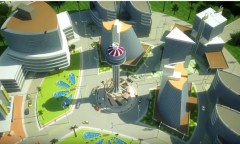By Prei Dy, | February 13, 2017

China's Luojia-1A could reportedly carry a highly sensitive night light camera with a 100-meter ground image resolution.
China is set to launch this year its first remote-sensing satellite, the Luojia-1A, which could detect lighted structures on the ground at night.
The 10-kilogram mini satellite will reportedly carry a highly sensitive night light camera with a 100-meter ground image resolution. It could detect large lighted structures on the ground within a designated observation area, project's chief scientist Li Deren told China News Service.
Like Us on Facebook
The Luojia-1A, developed by scientists from Wuhan University in Hubei Province, boasts of taking images clearer than US-made satellites. The Luojia-1A will aims to aid economic planners and analysts to supply relevant research and data to lawmakers when they determine overseas trade measures.
Reports also revealed that another remote-sensing radar satellite, the Luojia-B, is also in the pipeline and is slated to be launched into the orbit in 2019. China's ambitious space program aims to carry out a record-high 30 space launch missions this year. The launches will be conducted by the Long March 5 and Long March 7 rockets, according to China Aerospace Science and Technology Corporation.
"Now we have satellites that have infrared imagers or synthetic aperture radars to obtain images of landscape or buildings. Compared with them, the Luojia-1A's camera is specifically developed to capture lighted objects at night, so it is very sensitive to light," Pang Zhihao, Space International magazine's executive editor-in-chief, said.
Meanwhile, China also claimed to have beaten NASA, confirming that its national space agency has already created a test device for the EmDrive and is being experimented in the low-orbit manned satellite Tiangong-2. It further said that NASA is merely "reconfirming" a technology that it already knew.
If the EmDrive, dubbed as the 'impossible machine', turns out a success, humans could reach the moon in just four hours and Mars in just a couple of weeks.
-
Use of Coronavirus Pandemic Drones Raises Privacy Concerns: Drones Spread Fear, Local Officials Say

-
Coronavirus Hampers The Delivery Of Lockheed Martin F-35 Stealth Fighters For 2020

-
Instagram Speeds Up Plans to Add Account Memorialization Feature Due to COVID-19 Deaths

-
NASA: Perseverance Plans to Bring 'Mars Rock' to Earth in 2031

-
600 Dead And 3,000 In The Hospital as Iranians Believed Drinking High-Concentrations of Alcohol Can Cure The Coronavirus

-
600 Dead And 3,000 In The Hospital as Iranians Believed Drinking High-Concentrations of Alcohol Can Cure The Coronavirus

-
COVID-19: Doctors, Nurses Use Virtual Reality to Learn New Skills in Treating Coronavirus Patients













